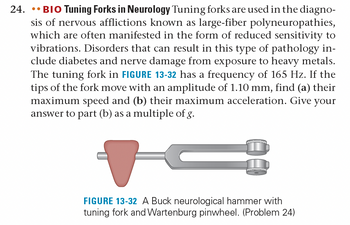
College Physics
11th Edition
ISBN: 9781305952300
Author: Raymond A. Serway, Chris Vuille
Publisher: Cengage Learning
expand_more
expand_more
format_list_bulleted
Concept explainers
Question
The answer must be typed - it cannot be hand-drawn
Please explain in the simplest amount of steps possible thank you

Transcribed Image Text:24.
.. BIO Tuning Forks in Neurology Tuning forks are used in the diagno-
sis of nervous afflictions known as large-fiber polyneuropathies,
which are often manifested in the form of reduced sensitivity to
vibrations. Disorders that can result in this type of pathology in-
clude diabetes and nerve damage from exposure to heavy metals.
The tuning fork in FIGURE 13-32 has a frequency of 165 Hz. If the
tips of the fork move with an amplitude of 1.10 mm, find (a) their
maximum speed and (b) their maximum acceleration. Give your
answer to part (b) as a multiple of g.
FIGURE 13-32 A Buck neurological hammer with
tuning fork and Wartenburg pinwheel. (Problem 24)
Expert Solution
This question has been solved!
Explore an expertly crafted, step-by-step solution for a thorough understanding of key concepts.
This is a popular solution
Trending nowThis is a popular solution!
Step by stepSolved in 4 steps with 5 images

Knowledge Booster
Learn more about
Need a deep-dive on the concept behind this application? Look no further. Learn more about this topic, physics and related others by exploring similar questions and additional content below.Similar questions
- Add the vectors A and B in the figure using the method of components. The magnitudes of both vectors are 2.55 m, and the angle vector A makes with the x-axis is 0 = 34.5°. Your result should be in unit-vector notation. (Give your answer in terms of meters.) A + B = L marrow_forwardThe magnitude of vector A is 26.0 units and points in the direction 310° counterclockwise from the positive x-axis. Calculate the x- and y-components of this vector. Ax = units Ay = unitsarrow_forwardVector A has a magnitude of 16.5 units and it points in a direction 300° counterclockwise from the positive x-axis. What are the x- and y-components of A? Ax = ___units Ay = ___unitsarrow_forward
- Don't use chat gpt Chatgpt means downvotearrow_forwardThe magnitude of vector A is 17.0 units and points in the direction 345° counterclockwise from the positive x-axis. Calculate the x- and y-components of this vector. Ax = units Ay = unitsarrow_forwardPlease select all that apply. Thank you!arrow_forward
- Find a vector representing wind coming from the southeast at 13 km/hr.arrow_forwardSolve ASAP in 10 minutesarrow_forwardVector A has a magnitude of 26 units and points in the positive y-direction. When vector B is added to A, the resultant vector A + B points in the negative y-direction with a magnitude of 11 units. Find the magnitude and direction of B. magnitude unit(s) direction ---Select---arrow_forward
- A vector has an x component of -24.5 m and a y component of 31.9 m. Find the magnitude and direction of this vector. The angle should be between 0 and 360.arrow_forwardThe highest waterfall in the world is Angel Falls in Venezula, with a total drop of 979 m. Write the height of the falls in cm using scientific notation. i x 104 cmarrow_forwardQuestion 5 A vector has an x-component of 4 m and makes an angle of 22° counterclockwise from the +x axis. What is its y-component? 1.6 m 1.5 m 4.3 m 4.0 marrow_forward
arrow_back_ios
SEE MORE QUESTIONS
arrow_forward_ios
Recommended textbooks for you
 College PhysicsPhysicsISBN:9781305952300Author:Raymond A. Serway, Chris VuillePublisher:Cengage Learning
College PhysicsPhysicsISBN:9781305952300Author:Raymond A. Serway, Chris VuillePublisher:Cengage Learning University Physics (14th Edition)PhysicsISBN:9780133969290Author:Hugh D. Young, Roger A. FreedmanPublisher:PEARSON
University Physics (14th Edition)PhysicsISBN:9780133969290Author:Hugh D. Young, Roger A. FreedmanPublisher:PEARSON Introduction To Quantum MechanicsPhysicsISBN:9781107189638Author:Griffiths, David J., Schroeter, Darrell F.Publisher:Cambridge University Press
Introduction To Quantum MechanicsPhysicsISBN:9781107189638Author:Griffiths, David J., Schroeter, Darrell F.Publisher:Cambridge University Press Physics for Scientists and EngineersPhysicsISBN:9781337553278Author:Raymond A. Serway, John W. JewettPublisher:Cengage Learning
Physics for Scientists and EngineersPhysicsISBN:9781337553278Author:Raymond A. Serway, John W. JewettPublisher:Cengage Learning Lecture- Tutorials for Introductory AstronomyPhysicsISBN:9780321820464Author:Edward E. Prather, Tim P. Slater, Jeff P. Adams, Gina BrissendenPublisher:Addison-Wesley
Lecture- Tutorials for Introductory AstronomyPhysicsISBN:9780321820464Author:Edward E. Prather, Tim P. Slater, Jeff P. Adams, Gina BrissendenPublisher:Addison-Wesley College Physics: A Strategic Approach (4th Editio...PhysicsISBN:9780134609034Author:Randall D. Knight (Professor Emeritus), Brian Jones, Stuart FieldPublisher:PEARSON
College Physics: A Strategic Approach (4th Editio...PhysicsISBN:9780134609034Author:Randall D. Knight (Professor Emeritus), Brian Jones, Stuart FieldPublisher:PEARSON

College Physics
Physics
ISBN:9781305952300
Author:Raymond A. Serway, Chris Vuille
Publisher:Cengage Learning

University Physics (14th Edition)
Physics
ISBN:9780133969290
Author:Hugh D. Young, Roger A. Freedman
Publisher:PEARSON

Introduction To Quantum Mechanics
Physics
ISBN:9781107189638
Author:Griffiths, David J., Schroeter, Darrell F.
Publisher:Cambridge University Press

Physics for Scientists and Engineers
Physics
ISBN:9781337553278
Author:Raymond A. Serway, John W. Jewett
Publisher:Cengage Learning

Lecture- Tutorials for Introductory Astronomy
Physics
ISBN:9780321820464
Author:Edward E. Prather, Tim P. Slater, Jeff P. Adams, Gina Brissenden
Publisher:Addison-Wesley

College Physics: A Strategic Approach (4th Editio...
Physics
ISBN:9780134609034
Author:Randall D. Knight (Professor Emeritus), Brian Jones, Stuart Field
Publisher:PEARSON